The Stratospheric Polar Vortex and Surface Effects: The Case of the North American 2018/19 Cold Winter
Abstract
:1. Introduction
2. Data and Methodology
3. Results
3.1. The 2018/2019 Sudden Stratospheric Warming
3.2. Surface Signature and the Role of Downward Propagating Wave Packets
4. Summary and Conclusions
Author Contributions
Funding
Data Availability Statement
Acknowledgments
Conflicts of Interest
References
- Wang, T.; Zhang, Q.; Hannachi, A.; Lin, Y.; Hirooka, T. On the dynamics of the seasonal transitions in the two hemispheric high-latitude stratosphere. Tellus A 2019, 71, 1634949. [Google Scholar] [CrossRef]
- Baldwin, M.P.; Dunkerton, T.J. Stratospheric Harbingers of Anomalous Weather Regimes. Science 2001, 294, 581–584. [Google Scholar] [CrossRef]
- Vitart, F.A.R.; Anderson, D. Subseasonal to Seasonal Prediction Project: Bridging the gap between weather and climate. WMO Bull. 2012, 61, 23–28. [Google Scholar]
- Rao, J.; Garfinkel, C.I.; Butler, A.H. Chapter 14—Stratospheric polar vortex variability. In Atmospheric Oscillations; Guan, B., Ed.; Elsevier: Amsterdam, The Netherlands, 2025; pp. 277–299. [Google Scholar] [CrossRef]
- Thompson, D.W.J.; Baldwin, M.P.; Wallace, J.M. Stratospheric Connection to Northern Hemisphere Wintertime Weather: Implications for Prediction. J. Clim. 2002, 15, 1421–1428. [Google Scholar] [CrossRef]
- O’Neill, A.; Charlton-Perez, A.; Polvani, L. MIDDLE ATMOSPHERE—Stratospheric Sudden Warmings. In Encyclopedia of Atmospheric Sciences, 2nd ed.; North, G.R., Pyle, J., Zhang, F., Eds.; Academic Press: Oxford, UK, 2015; pp. 30–40. [Google Scholar] [CrossRef]
- Varotsos, C.A.; Cracknell, A.P.; Tzanis, C. The exceptional ozone depletion over the Arctic in January–March 2011. Remote. Sens. Lett. 2012, 3, 343–352. [Google Scholar] [CrossRef]
- Varotsos, C.; Efstathiou, M.; Christodoulakis, J. The lesson learned from the unprecedented ozone hole in the Arctic in 2020; A novel nowcasting tool for such extreme events. J. Atmos. Sol.-Terr. Phys. 2020, 207, 105330. [Google Scholar] [CrossRef]
- Charney, J.G.; Drazin, P.G. Propagation of planetary-scale disturbances from the lower into the upper atmosphere. J. Geophys. Res. 1961, 66, 83–109. [Google Scholar] [CrossRef]
- Andrews, D.G.; Holton, J.R.; Leovy, C.B. Middle Atmosphere Dynamics, 1st ed.; Academic Press: Cambridge, MA, USA, 1987. [Google Scholar]
- Hannachi, A.; Mitchell, D.; Gray, L.; Charlton-Perez, A. On the use of geometric moments to examine the continuum of sudden stratospheric warmings. J. Atmos. Sci. 2011, 68, 657–674. [Google Scholar] [CrossRef]
- Bancalá, S.; Krüger, K.; Giorgetta, M. The preconditioning of major sudden stratospheric warmings. J. Geophys. Res. Atmos. 2012, 117., D04101. [Google Scholar] [CrossRef]
- Kidson, J.; Scaife, A.A.; Hardiman, S.C.; Mitchell, D.M.; Butchart, N.; Baldwin, M.P.; Gray, L.J. Stratospheric influence on tropospheric jet streams, storm tracks and surface weather. Nat. Geosci. 2015, 8, 433–440. [Google Scholar] [CrossRef]
- Harada, Y.; Hirooka, T. Extraordinary Features of the Planetary Wave Propagation During the Boreal Winter 2013/2014 and the Zonal Wave Number Two Predominance. J. Geophys. Res. Atmos. 2017, 122, 11374–11387. [Google Scholar] [CrossRef]
- Liu, S.M.; Chen, Y.H.; Rao, J.; Cao, C.; Li, S.Y.; Ma, M.H.; Wang, Y.B. Parallel Comparison of Major Sudden Stratospheric Warming Events in CESM1-WACCM and CESM2-WACCM. Atmosphere 2019, 10, 679. [Google Scholar] [CrossRef]
- Mitchell, D.M.; Gray, L.J.; Anstey, J.; Baldwin, M.P.; Charlton-Perez, A.J. The Influence of Stratospheric Vortex Displacements and Splits on Surface Climate. J. Clim. 2013, 26, 2668–2682. [Google Scholar] [CrossRef]
- Baldwin, M.P.; Dunkerton, T.J. Propagation of the Arctic Oscillation from the stratosphere to the troposphere. J. Geophys. Res. Atmos. 1999, 104, 30937–30946. [Google Scholar] [CrossRef]
- Julian, P.R.; Labitzke, K.B. A study of atmospheric energetics during the January-February 1963 stratospheric warming. J. Atmos. Sci. 1965, 22, 597–610. [Google Scholar] [CrossRef]
- Quiroz, R.S. Tropospheric-stratospheric polar vortex breakdown of January 1977. Geophys. Res. Lett. 1977, 4, 151–154. [Google Scholar] [CrossRef]
- Thompson, D.W.; Wallace, J.M. Annular modes in the extratropical circulation. Part I: Month-to-month variability. J. Clim. 2000, 13, 1000–1016. [Google Scholar] [CrossRef]
- Iqbal, W.; Hannachi, A.; Hirooka, T.; Chafik, L.; Harada, Y. Troposphere-stratosphere dynamical coupling in regard to the North Atlantic eddy-driven jet variability. J. Meteorol. Soc. Jpn. 2019, 97, 657–671. [Google Scholar] [CrossRef]
- Cao, C.; Chen, Y.H.; Rao, J.; Liu, S.M.; Li, S.Y.; Ma, M.H.; Wang, Y.B. Statistical Characteristics of Major Sudden Stratospheric Warming Events in CESM1-WACCM: A Comparison with the JRA55 and NCEP/NCAR Reanalyses. Atmosphere 2019, 10, 519. [Google Scholar] [CrossRef]
- Liang, Z.; Rao, J.; Guo, D.; Lu, Q.; Shi, C. Northern winter stratospheric polar vortex regimes and their possible influence on the extratropical troposphere. Clim. Dyn. 2023, 60, 3167–3186. [Google Scholar] [CrossRef]
- Kodera, K.; Mukougawa, H.; Itoh, S. Tropospheric impact of reflected planetary waves from the stratosphere. Geophys. Res. Lett. 2008, 35, L16806. [Google Scholar] [CrossRef]
- Kodera, K.; Mukougawa, H.; Fujii, A. Influence of the vertical and zonal propagation of stratospheric planetary waves on tropospheric blockings. J. Geophys. Res. Atmos. 2013, 118, 8333–8345. [Google Scholar] [CrossRef]
- Kodera, K.; Mukougawa, H.; Maury, P.; Ueda, M.; Claud, C. Absorbing and reflecting sudden stratospheric warming events and their relationship with tropospheric circulation. J. Geophys. Res. Atmos. 2016, 121, 80–94. [Google Scholar] [CrossRef]
- Perlwitz, J.; Harnik, N. Observational Evidence of a Stratospheric Influence on the Troposphere by Planetary Wave Reflection. J. Clim. 2003, 16, 3011–3026. [Google Scholar]
- Perlwitz, J.; Harnik, N. Downward Coupling between the Stratosphere and Troposphere: The Relative Roles of Wave and Zonal Mean Processes. J. Clim. 2004, 17, 4902–4909. [Google Scholar] [CrossRef]
- Shaw, T.A.; Perlwitz, J.; Harnik, N. Downward Wave Coupling between the Stratosphere and Troposphere: The Importance of Meridional Wave Guiding and Comparison with Zonal-Mean Coupling. J. Clim. 2010, 23, 6365–6381. [Google Scholar] [CrossRef]
- Matthias, V.; Kretschmer, M. The Influence of Stratospheric Wave Reflection on North American Cold Spells. Mon. Weather. Rev. 2020, 148, 1675–1690. [Google Scholar] [CrossRef]
- Millin, O.T.; Furtado, J.C.; Basara, J.B. Characteristics, Evolution, and Formation of Cold Air Outbreaks in the Great Plains of the United States. J. Clim. 2022, 35, 4585–4602. [Google Scholar] [CrossRef]
- Messori, G.; Kretschmer, M.; Lee, S.H.; Wendt, V. Stratospheric downward wave reflection events modulate North American weather regimes and cold spells. Weather. Clim. Dyn. 2022, 3, 1215–1236. [Google Scholar] [CrossRef]
- Kretschmer, M.; Cohen, J.; Matthias, V.; Runge, J.; Coumou, D. The different stratospheric influence on cold-extremes in Eurasia and North America. npj Clim. Atmos. Sci. 2018, 1, 44. [Google Scholar] [CrossRef]
- Lu, Q.; Rao, J.; Ren, R.; Shi, C.; Liu, S. Enhanced stratosphere-troposphere and tropics-Arctic couplings in the 2023/24 winter. Commun. Earth Environ. 2024, 5, 631. [Google Scholar] [CrossRef]
- Lee, S.H.; Butler, A.H. The 2018–2019 Arctic stratospheric polar vortex. Weather 2020, 75, 52–57. [Google Scholar] [CrossRef]
- Butler, A.H.; Lawrence, Z.D.; Lee, S.H.; Lillo, S.P.; Long, C.S. Differences between the 2018 and 2019 stratospheric polar vortex split events. Q. J. R. Meteorol. Soc. 2020, 146, 3503–3521. [Google Scholar] [CrossRef]
- Ma, Z.; Gong, Y.; Zhang, S.; Luo, J.; Zhou, Q.; Huang, C.; Huang, K. Comparison of stratospheric evolution during the major sudden stratospheric warming events in 2018 and 2019. Earth Planet. Phys. 2020, 4, 493–503. [Google Scholar] [CrossRef]
- Roy, R.; Kuttippurath, J. The dynamical evolution of Sudden Stratospheric Warmings of the Arctic winters in the past decade 2011–2021. SN Appl. Sci. 2022, 4, 105. [Google Scholar] [CrossRef]
- Knight, J.; Scaife, A.; Bett, P.E.; Collier, T.; Dunstone, N.; Gordon, M.; Hardiman, S.; Hermanson, L.; Ineson, S.; Kay, G.; et al. Predictability of European Winters 2017/2018 and 2018/2019: Contrasting influences from the Tropics and stratosphere. Atmos. Sci. Lett. 2021, 22, e1009. [Google Scholar] [CrossRef]
- Rao, J.; Garfinkel, C.I.; Chen, H.; White, I.P. The 2019 New Year Stratospheric Sudden Warming and Its Real-Time Predictions in Multiple S2S Models. J. Geophys. Res. Atmos. 2019, 124, 11155–11174. [Google Scholar] [CrossRef]
- Rao, J.; Garfinkel, C.I.; White, I.P. Predicting the Downward and Surface Influence of the February 2018 and January 2019 Sudden Stratospheric Warming Events in Subseasonal to Seasonal (S2S) Models. J. Geophys. Res. Atmos. 2020, 125, e2019JD031919. [Google Scholar] [CrossRef]
- Toptunova, O.; Motsakov, M.; Koval, A.; Ermakova, T.; Didenko, K. Impact of sudden stratospheric warming on tropospheric circulation and a cold wave formation: The case of the January 2019 event. Atmos. Res. 2025, 318, 107998. [Google Scholar] [CrossRef]
- Kobayashi, S.; Ota, Y.; Harada, Y.; Ebita, A.; Moriya, M.; Onoda, H.; Onogi, K.; Kamahori, H.; Kobayashi, C.; Endo, H.; et al. The JRA-55 Reanalysis: General specifications and basic characteristics. J. Meteorol. Soc. Jpn. 2015, 93, 5–48. [Google Scholar] [CrossRef]
- Harada, Y.; Kamahori, H.; Kobayashi, C.; Endo, H.; Kobayashi, S.; Ota, Y.; Onoda, H.; Onogi, K.; Miyaoka, K.; Takahashi, K. The JRA-55 Reanalysis: Representation of atmospheric circulation and climate variability. J. Meteorol. Soc. Jpn. 2016, 94, 269–302. [Google Scholar] [CrossRef]
- Kanamitsu, M.; Ebisuzaki, W.; Woollen, J.; Yang, S.K.; Hnilo, J.; Fiorino, M.; Potter, G.L. NCEP-DOE AMIP-II Reanalysis (R-2). Bull. Am. Meteorol. Soc. 2002, 83, 1631–1643. [Google Scholar] [CrossRef]
- CPC. AO and NAO Index from Climate Prediction Center of the National Oceanographic and Atmospheric Administration/National Weather Service. Available online: https://www.cpc.ncep.noaa.gov/products/precip/CWlink/daily_ao_index/teleconnections.shtml (accessed on 1 February 2023).
- Andrews, D.G. On the interpretation of the eliassen-palm flux divergence. Q. J. R. Meteorol. Soc. 1987, 113, 323–338. [Google Scholar] [CrossRef]
- Jucker, M. Scaling of Eliassen-Palm flux vectors. Atmos. Sci. Lett. 2021, 22, e1020. [Google Scholar] [CrossRef]
- Hannachi, A.; Lechner, M.; Finke, K.; Mukhin, D. Stratospheric polar vortex, wave absorption/reflection and effect on surface climate. Clim. Dyn. 2025, 63, 126. [Google Scholar] [CrossRef]
- Plumb, R.A. On the Three-Dimensional Propagation of Stationary Waves. J. Atmos. Sci. 1985, 42, 217–229. [Google Scholar] [CrossRef]
- Tibaldi, S.; Molteni, F. On the operational predictability of blocking. Tellus A 1990, 42, 343–365. [Google Scholar] [CrossRef]
- Lee, S.H.; Furtado, J.C.; Charlton-Perez, A.J. Wintertime North American Weather Regimes and the Arctic Stratospheric Polar Vortex. Geophys. Res. Lett. 2019, 46, 14892–14900. [Google Scholar] [CrossRef]
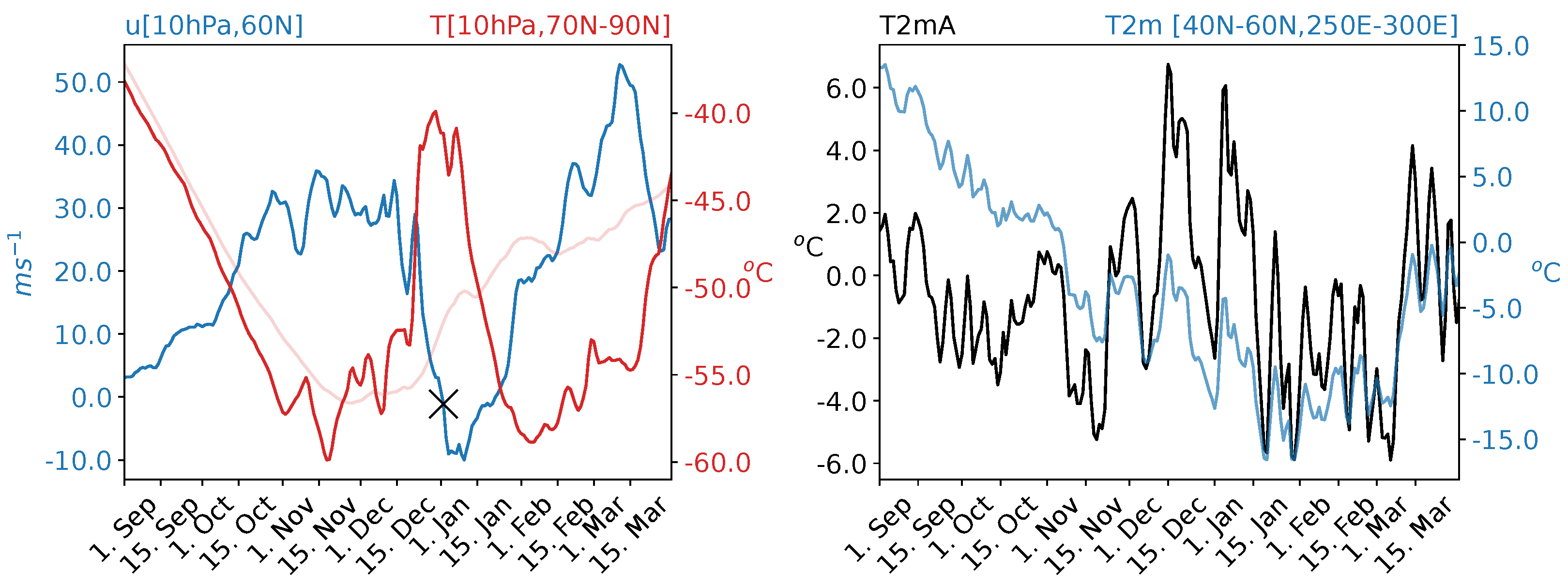

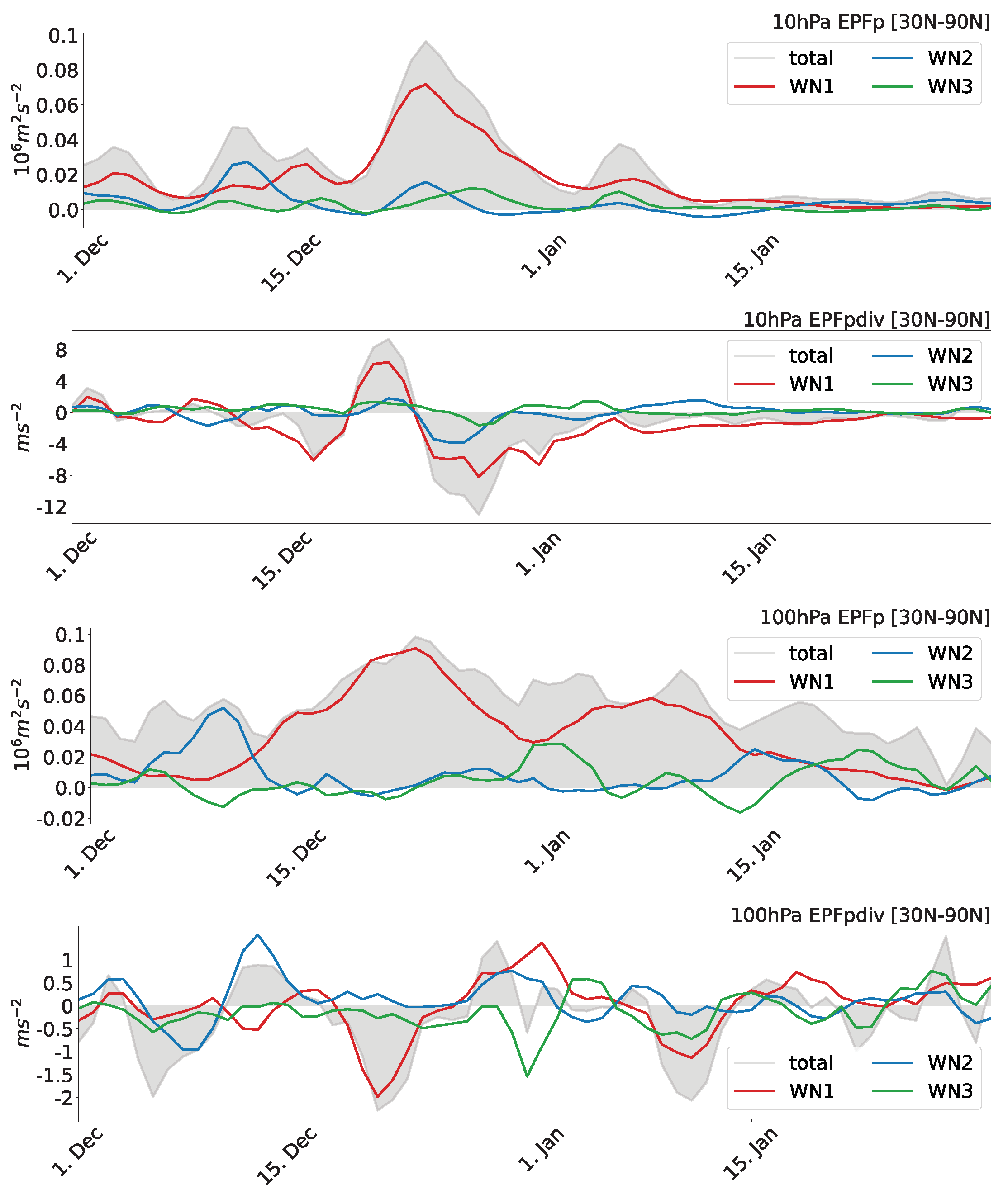
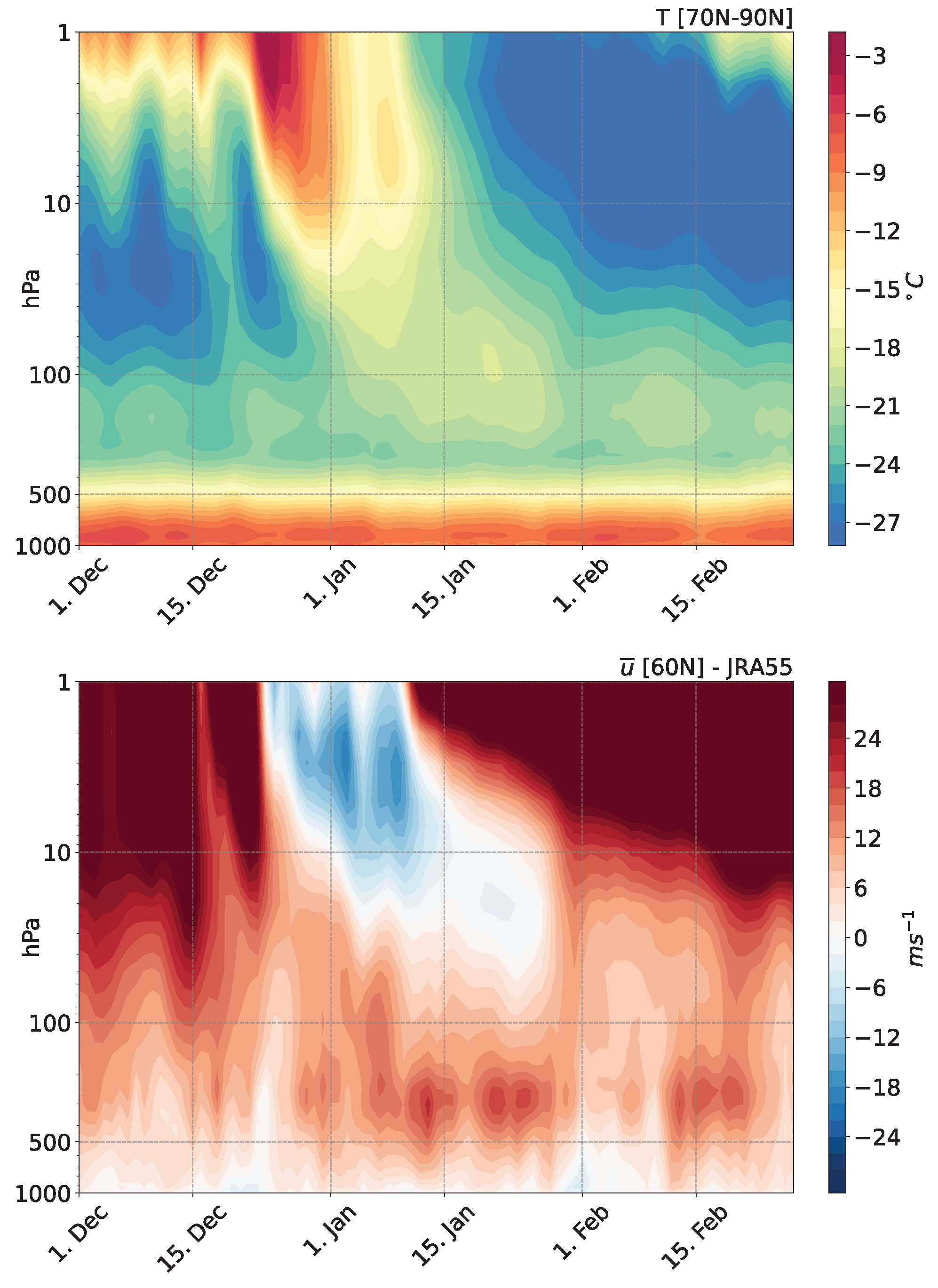


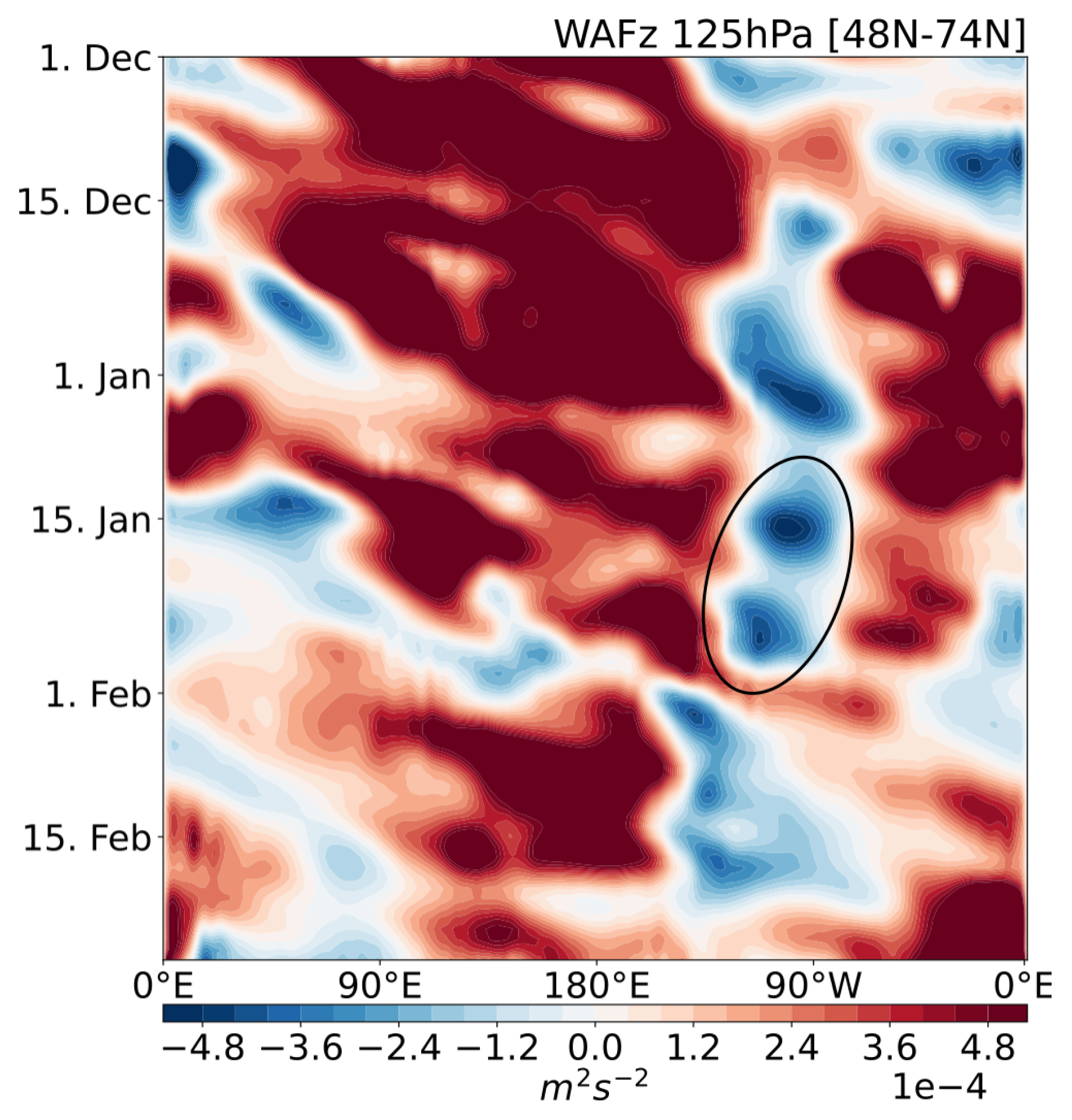

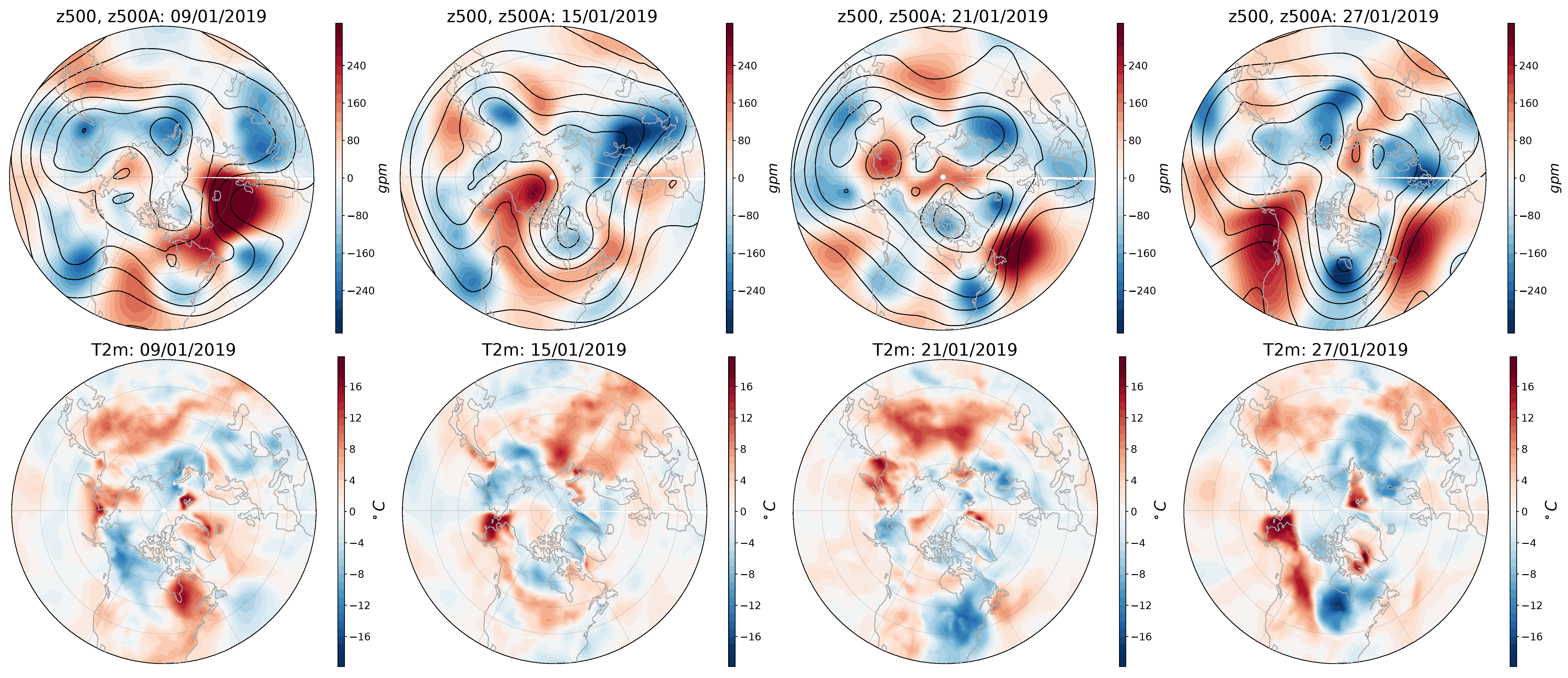
Disclaimer/Publisher’s Note: The statements, opinions and data contained in all publications are solely those of the individual author(s) and contributor(s) and not of MDPI and/or the editor(s). MDPI and/or the editor(s) disclaim responsibility for any injury to people or property resulting from any ideas, methods, instructions or products referred to in the content. |
© 2025 by the authors. Licensee MDPI, Basel, Switzerland. This article is an open access article distributed under the terms and conditions of the Creative Commons Attribution (CC BY) license (https://creativecommons.org/licenses/by/4.0/).
Share and Cite
Finke, K.; Hannachi, A.; Hirooka, T.; Matsuyama, Y.; Iqbal, W. The Stratospheric Polar Vortex and Surface Effects: The Case of the North American 2018/19 Cold Winter. Atmosphere 2025, 16, 445. https://doi.org/10.3390/atmos16040445
Finke K, Hannachi A, Hirooka T, Matsuyama Y, Iqbal W. The Stratospheric Polar Vortex and Surface Effects: The Case of the North American 2018/19 Cold Winter. Atmosphere. 2025; 16(4):445. https://doi.org/10.3390/atmos16040445
Chicago/Turabian StyleFinke, Kathrin, Abdel Hannachi, Toshihiko Hirooka, Yuya Matsuyama, and Waheed Iqbal. 2025. "The Stratospheric Polar Vortex and Surface Effects: The Case of the North American 2018/19 Cold Winter" Atmosphere 16, no. 4: 445. https://doi.org/10.3390/atmos16040445
APA StyleFinke, K., Hannachi, A., Hirooka, T., Matsuyama, Y., & Iqbal, W. (2025). The Stratospheric Polar Vortex and Surface Effects: The Case of the North American 2018/19 Cold Winter. Atmosphere, 16(4), 445. https://doi.org/10.3390/atmos16040445






